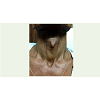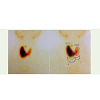Clinical Image
Graves’ disease with Unilateral Thyroidhypoplasia
Sugata Narayan Biswas1*, Partha Pratim Chakraborty2 and Rana Bhattacharjee3>
Corresponding author: Dr. Sugata Narayan Biswas, MBBS, Resident (Medicine), Department of Medicine, MidnaporeMedical College, Hospital Road, Paschim Medinipur, Pin: 721101, West Bengal, India,; E-mail: ruds444@gmail.com
Citation: Biswas SN, Chakraborty PP, Bhattacharjee R. Graves’ disease with Unilateral Thyroid hypoplasia. Indian J Appl Radiol. 2015;1(1): 103.
Copyright © 2015 Biswas SN et al. This is an open access article distributed under the Creative Commons Attribution License, which permits unrestricted use, distribution, and reproduction in any medium, provided the original work is properly cited.
Indian Journal of Applied Radiology | Volume: 1, Issue: 1
Submission: 20/05/2015; Accepted: 29/06/2015; Published: 04/07/2015
Keywords: Unilateral thyroid hypoplasia; Graves’ disease;Congenital anomaly
Image (Resident and Student Section),
A 45-year-old man was referred to us with a “thyroid nodule”.There was history of palpitation, tremulousness and heat intolerancefor 9 months, and weight loss of 5 kgs in the last 6 months. He wasunaware of any eye symptom. There was no family history of thyroiddisease. He had no addiction. On clinical examination, pulse rate of116 beats per minute; blood pressure of 128/62 mm of Hg and BMI of19.1 kg/m2 were recorded. There was fine postural tremor. Right lobe of thyroid and isthmus were diffusely enlarged and firm on palpation.However, the left lobe of thyroid gland was not palpable. Thyroidfunction tests revealed a serum TSH < 0.01 mcIU/ml (normal 0.4-4),free T4 3.2 ng/dl (normal 0.8-1.8) and total T3 269 ng/dl (normal70-190). Technetium 99m (99mTc) pertechnetate scintiscan revealeddiffusely increased radiotracer uptake in the right lobe of thyroidgland. The left lobe was found to be hypoplastic. USG of thyroidrevealed diffusely enlarged right lobe and a small left lobe. There wasno nodule detected. Anti-TSH receptor antibody titre was 2.3 IU/L (>1.7 – strongly positive). Diagnosis of Graves’ disease was made and after discussing various treatment options with the patient, he wasput on carbimazole 30 mg per day Figure 1,2.
Unilateral Thyroid hypoplasia (UTH) is a rare congenital anomaly.In overwhelming majority, the left lobe is affected. It usually occurssporadically but few familial cases have been reported [1]. Most ofsuch patients are euthyroid. The incidence of hypothyroidism wasfound to be higher than control subjects [2]. Association of Graves’disease with this malformation has rarely been reported.
Contributors
SNB and PPC contributed to diagnosis of patient, acquisition ofdata, concept and design of paper, drafting, critical revision of the article and final approval. RB contributed to diagnosis of patient,concept and design of paper, drafting, critical revision and intellectualinput and final approval of article.
References
- Castanet M, Leenhardt L, Léger J, Simon-Carré A, Lyonnet S, et al. (2005)Thyroid hemiagenesis is a rare variant of thyroid dysgenesis with a familial component but without Pax8 mutations in a cohort of 22 cases. Pediatr Res 57: 908‑913.
- Oh SH, Lee KY, Im JH, Lee MS. Chorea associated with non-ketotic hyperglycemia and hyperintensity basal ganglia lesion on T1-weighted brain MRI study: a meta-analysis of 53 cases including four present cases. J NeurolSci. 2002; 200:57-62.


